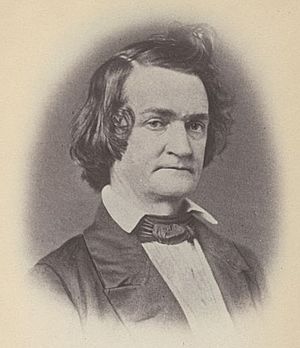Lewis D. Campbell facts for kids
Quick facts for kids
Lewis Davis Campbell
|
|
|---|---|
 |
|
| United States Minister to Mexico | |
| In office 1866–1867 |
|
| President | Andrew Johnson |
| Preceded by | Robert W. Shufelt |
| Succeeded by | Marcus Otterbourg |
| Member of the U.S. House of Representatives from Ohio's 2nd district |
|
| In office March 4, 1849 – March 3, 1853 |
|
| Preceded by | David Fisher |
| Succeeded by | John Scott Harrison |
| Member of the U.S. House of Representatives from Ohio's 3rd district |
|
| In office March 4, 1853 – May 25, 1858 |
|
| Preceded by | Hiram Bell |
| Succeeded by | Clement Vallandigham |
| In office March 4, 1871 – March 3, 1873 |
|
| Preceded by | Robert C. Schenck |
| Succeeded by | John Quincy Smith |
| Member of the Ohio Senate | |
| In office 1869–1870 |
|
| Personal details | |
| Born | August 9, 1811 Franklin, Warren County, Ohio |
| Died | November 26, 1882 (aged 71) Hamilton, Ohio |
| Resting place | Greenwood Cemetery |
| Political party | |
| Signature | |
Lewis Davis Campbell (born August 9, 1811 – died November 26, 1882) was an American politician from Ohio. He served as a U.S. Representative for Ohio. Interestingly, he was elected under several different political parties during his career. These included the Whig, Republican, and Democratic parties.
Contents
Early Life and Education
Lewis Campbell was born in Franklin, Ohio, in Warren County, Ohio. He went to public schools in his hometown. From 1828 to 1831, he learned the skill of printing. After that, he worked as an assistant editor for the Cincinnati Gazette newspaper.
He also started his own newspaper, The Hamilton Intelligencer, in Hamilton, Ohio. This paper supported Henry Clay and the Whig Party from 1831 to 1835. During this time, he also studied law. He became a lawyer in 1835 and practiced law in Hamilton until 1850. He also worked in farming. On January 5, 1836, he married Jane Reily in Butler County, Ohio.
Business Ventures
Lewis Campbell was involved in several important businesses. He was a director and secretary of the Hamilton and Rossville Hydraulic Company. This company was created in 1841 to build a canal through Hamilton. The canal provided water power to local businesses.
He also helped start and became president of the Cincinnati, Hamilton and Dayton Railroad Company. This railroad was built between 1846 and 1852. It helped connect cities and transport goods.
Early Political Career
Campbell tried to get elected to Congress several times before succeeding. He ran as a Whig candidate in 1840, 1842, and 1844 but did not win. Finally, in 1848, he was elected as a Whig from Ohio's 2nd District to the 31st Congress. He was re-elected in 1850.
After new district lines were drawn in 1850, he was in Ohio's 3rd District. He was elected again as a Whig in 1852. As the Whig Party became weaker, he ran as an Opposition Party candidate in 1854. He was elected to the 34th Congress. He became the chairman of the House Committee on Ways and Means. This was a very important committee that dealt with government money and taxes.
Debates and Tensions
In 1854, during discussions about the Kansas–Nebraska Act, Campbell, who was against slavery, tried to stop a vote. He did this by giving a very long speech, a tactic known as a filibuster. This made Henry A. Edmundson, a pro-slavery politician from Virginia, very angry.
On May 12, 1854, the situation became very tense. Campbell and other anti-slavery politicians from the North argued fiercely with Southern politicians. The arguments became so heated that some members even showed their weapons in the House of Representatives. Henry A. Edmundson had to be held back from attacking Campbell. The House had to stop its meeting to calm things down.
Contested Election
In 1856, Campbell believed he had won re-election by a small number of votes. He served in Congress from March 4, 1857. However, his election was challenged by Clement Vallandigham. On May 25, 1858, the House of Representatives voted that Campbell was not entitled to his seat. Vallandigham then took his place. Campbell ran against Vallandigham again in 1858 but lost by a very small margin.
Civil War Service
When the American Civil War began, Campbell joined the Union Army. He served as a colonel, leading the 69th Regiment, Ohio Volunteer Infantry. He served in 1861 and 1862. He later resigned from his military role due to health problems.
Postwar Career
After the Civil War, President Andrew Johnson appointed Lewis Campbell as the U.S. Minister to Mexico. This happened on May 4, 1866. He traveled with General William Tecumseh Sherman. Campbell's job was to show that the United States supported President Benito Juárez of Mexico. He was also supposed to offer U.S. military help to restore order in Mexico.
At that time, French forces were occupying Mexico and supporting Emperor Maximilian. President Juarez's government was on the run, and Campbell was unable to reach them. Campbell served as Minister to Mexico until June 16, 1867, when he resigned. He then returned to Ohio to continue his political career.
Campbell was elected to the Ohio Senate in 1869. He resigned in 1870 to return to Congress, this time as a Democrat. He served in the 42nd Congress. He chose not to run for re-election in 1872. In 1873, he was a delegate to the third Ohio State constitutional convention. After this, he went back to working in agriculture.
Death and Legacy
Lewis Campbell passed away in Hamilton, Ohio, on November 26, 1882, at the age of 71. He is buried in Greenwood Cemetery. His nephew, James E. Campbell, later held the same congressional seat from Ohio's 3rd District for one term.
Images for kids



